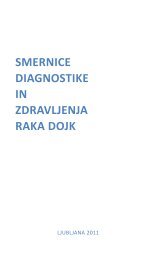Create successful ePaper yourself
Turn your PDF publications into a flip-book with our unique Google optimized e-Paper software.
Immunohistochemistry in oncology: a tool for diagnosis, prognosis and<br />
treatment<br />
Paule Opolon<br />
CNRS UMR 8121, Institut Gustave-Roussy, Villejuif 94805, France<br />
Immunohistochemistry enables the visualization <strong>of</strong> specific antigens tissue distribution.<br />
It localizes protein targets <strong>of</strong> interest by applying specific monoclonal or polyclonal<br />
antibodies to tissue surfaces in a process called antibody incubation. This technique was<br />
developed since the 1940’s, when Coons and colleagues from Harvard Medical School<br />
described the identification <strong>of</strong> tissue antigens by using a direct fluorescence protocol.<br />
Detection <strong>of</strong> reliable fluorescent signals was initiated by pharmaceutical chemists, such<br />
as Riggs, in 1961, who replaced the toxic and unstable compound isocyanate by a more<br />
stable dye, fluorescein isothiocyanate (FITC). The first applications <strong>of</strong> this method were<br />
bacteriology and the diagnosis <strong>of</strong> autoimmune diseases. The availability <strong>of</strong> numerous<br />
specific monoclonal antibodies in the 1970’s provided major advances in pathology,<br />
internal medicine and oncology. Immunohistoenzymology coupled with transmission<br />
microscopy (vs immun<strong>of</strong>luorescence), is the elective method for many surgical pathologists<br />
since it makes it possible to visualise at once signals and adjacent structures.<br />
In the field <strong>of</strong> oncology, histological markers (which are not always correlated to seric<br />
markers) allowed major advances in basic research and clinical science: for example<br />
estrogen receptors detection on histological slides in breast cancer is a validated routine<br />
tool for therapy. In fundamental research, visualisation <strong>of</strong> growth factors, cytokines,<br />
apoptosis inhibitors, oncogenic proteins, hypoxia markers, endothelial cells and other cell<br />
types involved in angiogenesis, combined with various methods, such as those derived<br />
from molecular biology is a very valuable tool for the understanding <strong>of</strong> cancerogenesis<br />
mechanisms.<br />
However, interpretation <strong>of</strong> immunohistochemistry has to take into account the pitfalls<br />
<strong>of</strong> this method: poor specificity <strong>of</strong> some antibodies, discrepancies between hospitals <strong>of</strong>ten<br />
related to the<br />
l33<br />
heterogeneity <strong>of</strong> fixation procedures and, during many years, the drawback<br />
<strong>of</strong> an exclusively morphological approach. Early adepts <strong>of</strong> quantification <strong>of</strong> these signals<br />
spent longs hours counting manually histological structures such as blood vessels, with a<br />
poor intra-observer and inter-observer reproducibility.<br />
Since 2004, quantification <strong>of</strong> stained signals is performed at Gustave Roussy Institute in<br />
Villejuif with a system combining a dedicated slide scanner and a computer-assisted image<br />
analysis: PIXCYT is a s<strong>of</strong>tware package designed by the Groupe Régional d’Etudes sur<br />
le Cancer, Centre François Baclesse, Caen) and represents a revolutionary approach <strong>of</strong><br />
markers interpretation on histological slides for experimental pathology applications,<br />
such as the count <strong>of</strong> immunostained microvessels, nuclear or cytoplasmic stainings in<br />
tumor cells.<br />
Automation with a dedicated script implemented to PIXCYT proved to be very helpful<br />
for measurement <strong>of</strong> lung metastases surface in a model <strong>of</strong> B16F10 tumors xenografted<br />
in nude mice. This s<strong>of</strong>tware is also currently used to assess tumor microvessel density<br />
48
















